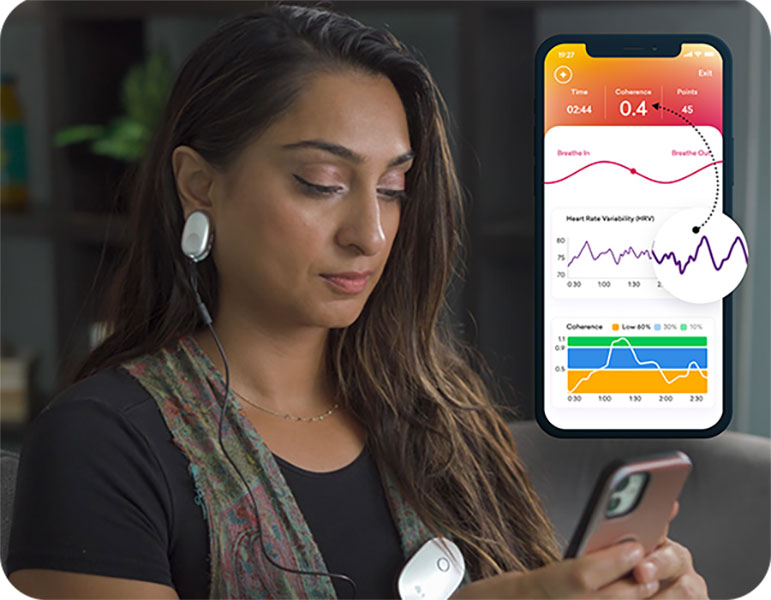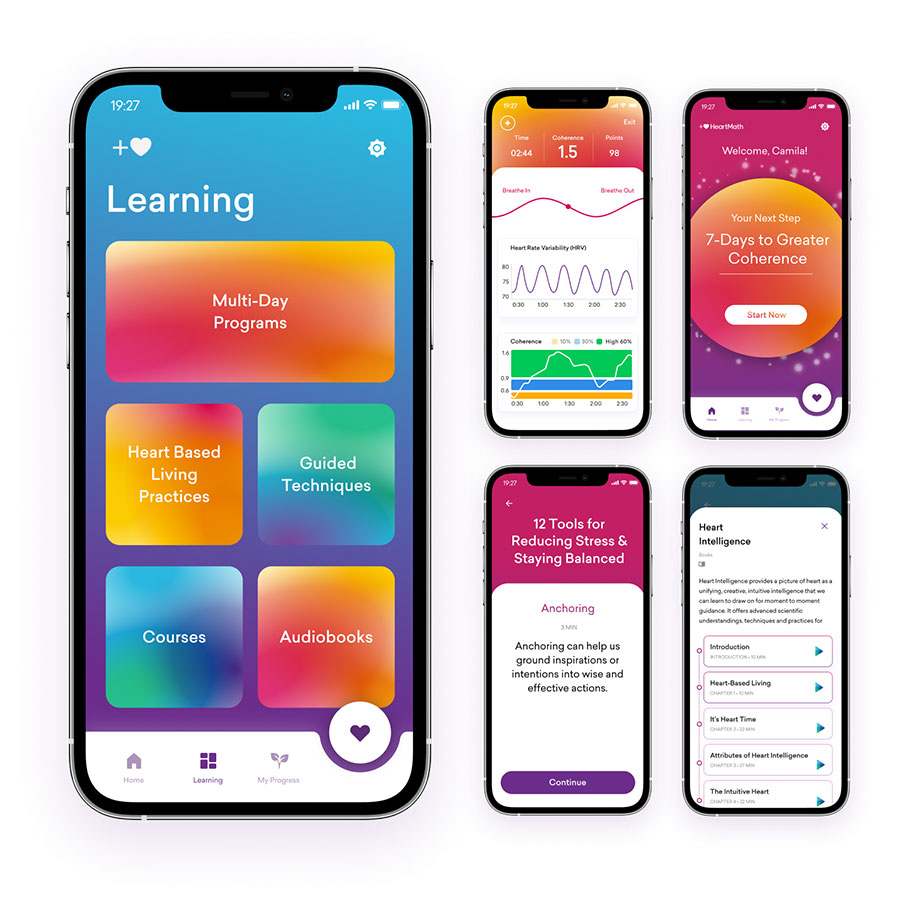Heart coherence has rapidly emerged as a vital concept in personal resilience, emotional regulation, and peak performance, yet its deeper significance remains overlooked by many. But what is coherence?
Imagine tapping into an inner rhythm that steadies your mind, deepens your intuition, and turns the momentum of stress into enduring clarity. In those moments, challenges feel smaller, ideas spark effortlessly, and emotional balance becomes second nature. Tools like HeartMath’s Inner Balance™ Coherence Plus sensor and companion app make it simple to measure and nurture coherence in your daily life.
Defining Heart Coherence: What Is Coherence Beyond a Buzzword
At its core, heart coherence refers to a harmonious alignment between the heart’s rhythm, brainwave activity, and the autonomic nervous system. In coherent states, the normally erratic beat‑to‑beat intervals of your heart become smooth, sine‑wave‑like patterns, indicating optimal neuro‑cardiac communication.
This pattern is quantified through heart‑rate variability (HRV), the millisecond‑to‑millisecond fluctuations that reveal your body’s adaptability to internal and external stimuli. When your HRV displays high amplitude and regular oscillations—what researchers call a coherent waveform—your emotional state, cognitive function, and physiological resilience are operating in synchrony.
Achieving heart coherence is akin to tuning an instrument: when strings vibrate in harmony, music flows; when your heart, brain, and emotions resonate together, you enter a flow state marked by heightened focus, creativity, and ease.
The Neuroscience of Flow and Coherence
Scientific studies have repeatedly linked coherent HRV patterns with improved cognitive performance, enhanced emotional balance, and better stress resilience—hallmarks of coherent functioning. But what is coherence, really?
Coherence activates the parasympathetic branch of the autonomic nervous system, facilitating a state of “rest and digest” that counters the fight‑or‑flight reaction. By strengthening vagal tone—the health and connectivity of the vagus nerve that governs heart‑brain communication—practitioners experience lowered cortisol levels and enhanced prefrontal cortex function, the seat of executive decision‑making.
Over time, regular coherence practice builds a new baseline for your nervous system, enabling you to respond to stressors with equanimity rather than reactivity. This adaptive shift not only reduces chronic wear‑and‑tear on tissues and organs but also cultivates sustained mental clarity, emotional intelligence, and physical vitality.
Recognizing Coherence in Daily Life
When someone attains heart coherence—with what is coherence becoming a lived reality—the results ripple across every aspect of their existence:
- Heightened Focus and Productivity: Tasks that once felt laborious flow effortlessly, as distractions fade and cognitive bandwidth expands.
- Emotional Resilience: Upsets are processed with perspective; triggers no longer hijack judgments.
- Enhanced Relationships: Presence replaces reactivity—conversations become more attuned and empathetic.
- Physical Well‑Being: Improved sleep quality, balanced blood pressure, and more efficient recovery from exercise and illness.
Consider entrepreneur Maya Thompson, who credits her daily coherence practice with transforming her back‑to‑back pitch sessions into opportunities for genuine connection rather than stress‑fueled endurance tests. “When I’m coherent,” she says, “I feel anchored—my ideas flow, and my confidence radiates without the jitters.”
HeartMath’s Inner Balance™: From Concept to Cutting‑Edge Wearable
Few wearable HRV devices deliver more than retrospective data; they show you that your body struggled last night or that your recovery score is low. But HeartMath’s Inner Balance™ Coherence Plus sensor stands apart by offering both real‑time measurement and guided training to shift into coherence on the spot.
“We don’t just track HRV. We train it—helping people shift into coherence in the moment,” explains Owen Ward, Chief Strategy Officer at HeartMath. “When your heart, brain, and emotions are in sync, you enter coherence—a trainable state that helps you feel better and function at your best. In training—using real‑time feedback—we start to understand what it feels like to be coherent and we can call upon it when we need it.”

Inside the Sensor: Optical Photodetectors and Signal‑Processing Algorithms
The Inner Balance™ Coherence Plus sensor is HeartMath’s most advanced wearable yet. Engineered with professional‑grade photodetectors that sample your pulse wave 500 times per second, the device captures ultra‑precise HRV data. Proprietary signal‑processing algorithms then filter noise and distill clean beat‑interval readings. Bluetooth Low Energy connectivity streams this data seamlessly to the HeartMath app, where real‑time coherence scores appear alongside intuitive breath pacing guides and personalized practice modules.
These optical sensors detect subtle changes in blood volume beneath the skin, while firmware‑driven algorithms perform on‑the‑fly artifact removal—ensuring every coherence metric reflects genuine physiological shifts rather than motion or ambient noise.
How Coherence Measurement Enhances Everyday Well‑Being
Real‑time coherence feedback empowers users to intercept stress before it escalates, providing a vivid demonstration of what is coherence in everyday life.
As Owen Ward tells us:
Coherence measured via HRV offers a uniquely sensitive window into our stress and emotional regulation by capturing the very patterns of heart‑brain communication that most wearables miss. Seeing real‑time coherence data illuminates how our thoughts, feelings, and breathing influence our physiology, and gives users the power to interrupt and transform unhelpful patterns the moment they arise—before overwhelm takes hold.
By visualizing coherence scores moment to moment, individuals learn to identify the physiological signatures of overwhelm—racing heartbeats, shallow breathing, irregular HRV—and pivot instantly with guided breathing and positive emotion techniques.
Over weeks of daily practice, the nervous system recalibrates, creating a higher baseline of coherence so that calm becomes your default response rather than a reactive retreat.
Training for Coherence: Practical Pro Tips
Much like strength training for muscles, coherence exercises fortify the nervous system:
- Optimal Sensor Placement: Attach the Inner Balance™ ear sensor clip to your earlobe or place the Bluetooth‑enabled sensor on the inner wrist for consistent pulse detection. Ensure snug contact—avoid clamping too tightly, which can occlude blood flow.
- Warm‑Up Routine: Begin with two minutes of natural awareness. Notice breath depth and ease into a gentle-paced breathing at 5‑6 seconds inhale/5‑6 seconds exhale, following the app’s animated pacer.
- Engage Positive Emotion: Recall uplifting memories—a special vacation, wedding day, birth of a child, or a cherished moment with a pet. Infusing breathwork with heartfelt gratitude amplifies coherence gains far beyond breathing alone.
- Focus on Feeling, Not Scores: Resist the temptation to chase numbers. Instead, ask yourself, “Am I in a coherent state? How does it feel? What anchored me here?” Reflection cements the mind‑body connection that sustains coherence off‑device.
- Consistency is Key: Commit to at least five minutes of daily practice, ideally at a fixed time—morning to set an aligned tone for the day, or evening to release accumulated tension. Use free time for brief sessions when possible. Use in‑app reminders to maintain ritual.
The Science‑Backed Benefits of Sustained Heart Coherence
Decades of peer‑reviewed research validate coherence techniques:
- Stress Reduction & Mental Health: Regular coherence practice lowers cortisol and catecholamine levels, mitigating anxiety, depression, and burnout risk.
- Enhanced Autonomic Balance: Improved vagal tone fosters resilient immune response and cardiovascular health.
- Cognitive Sharpness: Studies show coherent HRV correlates with superior decision‑making, working memory, and cognitive flexibility.
- Emotional Regulation: Practitioners report reduced emotional volatility and heightened empathy in social interactions.
For individuals with low HRV—a marker observed in a range of physical diseases and mental health challenges—HeartMath coherence‑building techniques can restore autonomic regulation and support the body’s innate regenerative processes.
Integrating Coherence into Holistic Wellness
While coherence training is powerful on its own, it harmonizes beautifully with other wellness practices:
- Mindful Movement: Pair coherence sessions with yoga flows or tai chi to deepen mind‑body integration.
- Nutrition & Hydration: Hydrated, nutrient‑rich cells yield clearer pulse readings and support optimal autonomic function.
- Sleep Hygiene: Use evening coherence practice to ease into restorative sleep, boosting nightly recovery.
Viewed through a holistic lens, heart coherence becomes the keystone habit that amplifies every other self‑care endeavor.
Cultivating Coherent Living
Heart coherence transcends mere metrics and unfolds as a lived harmony—grasping what is coherence reveals how it empowers you to meet life’s challenges with grace, clarity, and resilience.
By leveraging HeartMath’s Inner Balance™ Coherence Plus sensor and app, you gain both the real‑time mirror and the guided training to shift your nervous system toward coherence—anytime, anywhere.
As you cultivate this state through daily practice, you forge a new physiological baseline, one where calm, creativity, and connection become your default responses. That is the true power of heart coherence: an elegant, trainable flow state that transforms your mind, body, and spirit.

